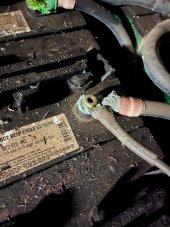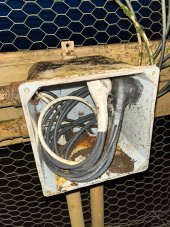Thank you all so much for all of the replies. I did not expect to get so much information back, but I want to really thank everyone who took the time to read it all and respond. Even the disagreement is insightful as I try to formulate a plan to deal with this issue. Since I got so much feedback, I will give and update and ask as much as I can think to ask. Thanks again for anyone who gives some advice
Since some of you seemed interested to know what has happened with this battery bank, the answer is nothing, yet. After my initial post I had to leave the property for some time and had things to deal with. The day before I came back, I spent it wondering around collecting supplies (battery hydrometer, 4-0 awg welding wire & lugs, dc clamp meter, etc), but didn't manage to find everything I needed. I decided to take sunshine_eggo's first suggested approach but got stopped at
clean and torque all connections. Many of the connections seem completely and totally unrepairable and, before I started taking things apart, I wanted to make sure I had the wire and connectors to put things back together. Not so easy to find around here. I will try again tomorrow evening.
In any case, to clarify on my ideas on the system, especially after reading this thread: I see now that the battery bank (or whatever survives the culling) as a whole needs to go in the near term future. I am planning on replacing the whole thing with a good LifePo4 bank as soon as I'm able. But with my time, resources, and supply limitations that could be between weeks and months. So I would like to keep the system running for at least that long, even at reduced capacity. The majority of the system has run for at least 10 years (the panel array, SCCs, inverter) and the battery bank for 2 or 3, so I figure some more months is reasonable given some maintenance and love (especially with people willing to help on this forum). Besides, this gives me an opportunity to learn something new.
Steps I've taken in the meantime:
1. Got the manuals for and recorded the inverter and SCC settings. Was worried about losing something if for some reason the battery bank died all-together before I could examine it. They were actually all the default settings.
2. Covered battery plates with distilled water (but did not top off). I did that before, but some had gone dry again.
3. Disconnected and reconnected AC and DC breaker. Verified the inverter will restart and power the place
Some questions I had before I make the effort to disassemble the bank:
- As some speculated there is no breaker or fuse between the panels and the SCC, or the SCC and the battery. The SCCs are at least grounded (sloppily looking, with some dangly green wire plugged into the dirt). I thought this wouldn't be a problem if I just did it at night, but at around 13:30 pm on an overcast night, the panels are reading between 10 and 15v in w/ 0 amps. Would still like to disconnect the panels/SCC before working on the bank. Also having read something about the potential to damage the SCC if disconnecting the battery but leaving the panels connected, I am wondering what I should do here. Disconnect the panels MC4 connectors, or at the SCC, or don't?
- Does anyone have any idea what this wire size and lug might be?

This is for the SCC to the battery terminal. Silly and probably unanswerable question based on the picture, but I have a feeling once I take that terminal off, I won't be able to get it back on without putting a new connector on. It basically doesn't exist anymore. Additionally, the Flexmax 80 recommends 2/0 AWG, and so this looks to be undersized. Perhaps a better question is should I run a whole new cable through the conduit?
- All of the battery interconnect cables vary from 2/0 AWG to 4/0 AWG. Looks like the former maintainer just made what he had available at the time (there's also a pile laying around I found of different sizes, makes me suspect he might have been just swapping in and out batteries and interconnects onsie twosie?). Moreover, parallel connections between series strings are all 4/0 AWG, but the parallel connection between 4x4 blocks is 2/0 AWG? doesn't seem logical. I am having trouble with the math of the parallel/series rats nest, can someone clarify for my curiosity what the actually correct
gauge interconnect is for a battery bank this size?
Finally, I am looking now at making the whole system safe and serviceable in the long-run while maintaining as many components as possible. I have resources, but can't spend a fortune on something brand new. Any advice in that direction would be greatly appreciated. Things I know to do now with the responses I got (besides fix the effed battery situation):
1. Add breakers between SCC/panels, SCC/batteries
2. Possibly move new battery bank closer to the inverter, but at the very least combine battery-inverter long run into one conduit housing
3. Fix the environment issue (chickens, no battery housing, etc)
4. Rexamine the wiring. Every time I look, I find things like this... the inside of the junction box coming from the panels. Something tells me there's a better way to do this?

Wow that ended up being a lot. If you read that all thanks a ton and any insight would be immensely appreciated. Some of you here probably take these things for granted. Let me tell you, I am a total noob, but I'm tryin to learn as fast as I can.
Finally finally finally not to get too off-topic, but if anyone has any recommendations on ~30kWh 24 volt battery bank replacements given Hawaii import restrictions,
I am all ears.




